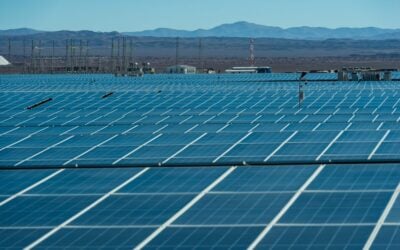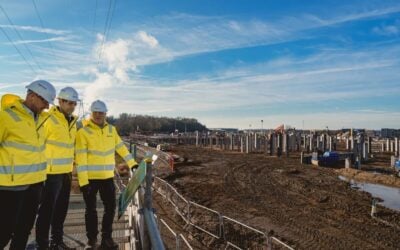Eaton and Nissan unveiled the collaboration at a press event in Paris. Image: Eaton / Nissan.
Behind-the-meter energy storage controls based around Nissan’s EV batteries and a ‘software-defined power plant’, both designed to incorporate a range of energy resources including solar, have been launched in the past few week.
The two separate products come from different makers but are both built on the principle that energy systems of the future will call on a diverse range of distributed power and energy resources to match supply with demand.
Last week carmaker Nissan and power electronics and engineering group Eaton unveiled a demonstration model of an energy storage control centre, which has been developed by the two companies at Eaton’s research facilities in Switzerland.
The control centre combines Eaton’s uninterruptible power supply (UPS) with second life – repurposed – Nissan Leaf batteries. It can manage multiple energy inputs, including solar, the grid and battery storage bi-directionally (managing the flow of power into and out of the system) and, the makers hope, manage various different applications for the system, including charging cheaply with off-peak electricity at night.
Try Premium for just $1
- Full premium access for the first month at only $1
- Converts to an annual rate after 30 days unless cancelled
- Cancel anytime during the trial period
Premium Benefits
- Expert industry analysis and interviews
- Digital access to PV Tech Power journal
- Exclusive event discounts
Or get the full Premium subscription right away
Or continue reading this article for free
The two companies hope that the system and further products developed through their partnership, which they have signed a Memorandum of Understanding (MoU) to cement, will be seen as an effective integrator of variable renewable energy output and therefore useful to balance the grid. They also hope that by combining both technologies and applications for energy storage and other distributed energy resources, system owners and operators will be able to use them to participate in demand response programmes or in selling energy back to the grid.
The EV and stationary storage industry are inextricably linked beyond the fact that both predominantly use lithium-ion batteries and are talked about enthusiastically by clean tech evangelists. In particular, rising volumes of production of batteries for e-mobility have contributed to the rapid fall in prices for stationary storage systems. There has also been a great deal of discussion about the feasibility of using second life batteries in grid-connected applications such as aggregating them to act as large-scale energy storage or putting them directly into home storage systems. However, there are significant differences in the way batteries are intended to be used and cycled in the two settings.
The storage capacity of the Eaton/Nissan demonstration system is 24kWh with brand new batteries, or 17kWh for second life batteries – using up to four batteries in parallel. It has a 50kW output at voltages of 230V/400V. The two companies hope the system can be further developed into a commercial offering.
More ‘software-defined power plants’ for Europe
Also operating on a similar principle of incorporating various distributed energy resources using energy storage but at a different scale, is the “software-defined power plant” concept launched today by US grid and analytics company Autogrid and Electro Power Systems.
France-headquartered Electro Power Systems (EPS) delivers oxygen and hydrogen energy storage systems internationally. The company, originally founded by the Polytechnic of Turin in Italy in 2005, officially opened an R&D and production centre in that city today, which it claims can produce 2MW of systems per month. In a busy day for news, the company also announced the acquisition of Italian system integrator Elvi Energy.
Using Autogrid’s software and energy management, EPS has developed a control system which can forecast, optimise and control a number of distributed energy resources in conjunction with hydrogen or oxygen-based energy storage.
CHP, solar or other resources can therefore be used as a dispatchable, flexible resource. As with the Eaton/Nissan system, this means the system owner or operator will be able to use it to play into demand response or electricity trading markets.
Autogrid recently also worked with Dutch gas and electricity supplier Eneco to put dispatchable and distributed software-defined power plant capabilities on the grid in Holland. Silicon Valley-headquartered Autogrid has worked in Asia and its own domestic market as well as its forays into Europe.
In a recent interview with PV Tech Storage, Autogrid director of business development John McClean said the company’s products were responding to the changing nature of energy supply, using utilities as an example.
“For years, utilities have done forecasting, optimisation to different degrees and they’ve done different types of control,” McClean said.
“What’s changed about what they need is that where they used dispatching a relatively small number of resources to a large load, now utilities need to do all of that forecasting, optimisation and control, in real-time and at scale, so the number of calculations has increased by orders magnitude,” he added.
Electro Power Systems’ hydrogen energy storage solution, combined with onsite PV. Image: Electro Power Systems.





